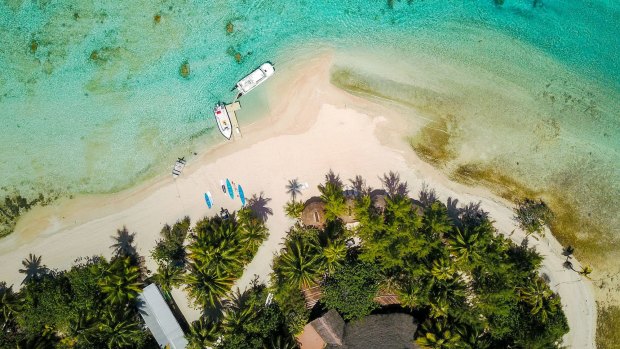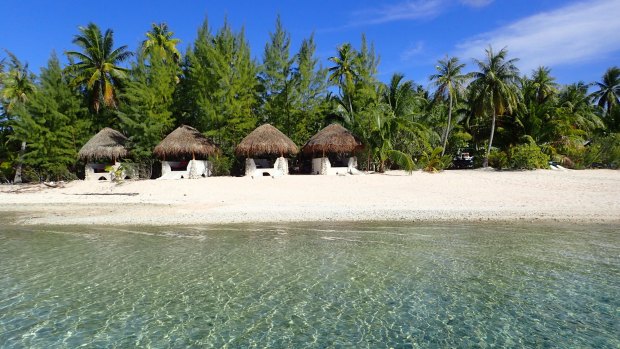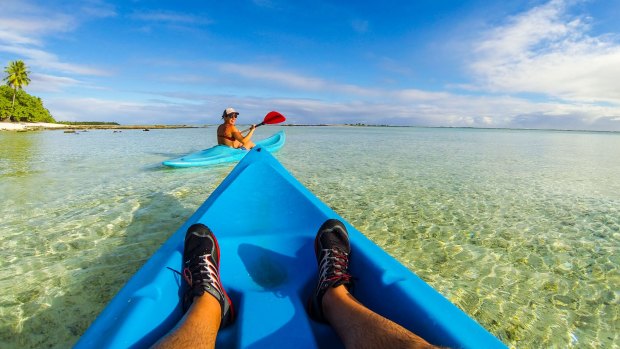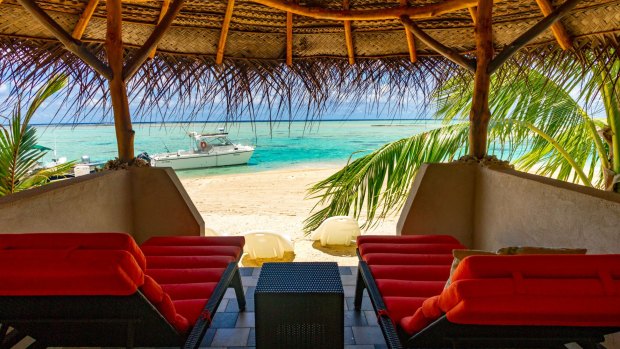This was published 6 years ago
Ninamu, Tikehau Atoll, Tahiti: A delicious drop in the ocean
By Daisy Dumas

It pays to cut yourself off from civilisation for a while - preferably on a tiny island paradise, Ninamu.
I am sitting on a lagoon's edge, under a palm tree, watching a Polynesian sunset.
It is as picture-postcardy as it sounds, but for the black-tipped triangles slicing through the glossy water not two metres from me. They are the same fins we see from our bedroom windows as the sun rises and the same fins we see from our lunch table as tuna carpaccio and fresh coconuts are served, small reef sharks on their incessant loops through knee-high, warm water. They are to Ninamu what huntsman spiders are to Australia: near-harmless and, to non-locals, a little misunderstood.
Tiny Motu Ninamu. forms part of the Palliser Islands' Tikehau Atoll, about an hour's flight from the French Polynesian capital, Pape'ete. With flights to the city from Australia via Auckland with Air New Zealand – its Boeing 787 Dreamliners comfortably cover the eight-or-so hours flying time – then twin-prop Air Tahiti flights internally and, finally, a boat from the main island, Ninamu is four flights and a boat ride from home, a private island so far-flung that it is barely visible on maps. Even as we prepare to leave the speed boat, Ninamu's tiny resort remains invisible, built to protect land and sea, first and foremost.

Ninamu from the sea.Credit: Tim Peltz
Its owner, Chris O'Callaghan, is a man with a back story. Variously a tradie, air steward, yachtie, surf competition founder (not just any surf comp, but Teahupo'o, possibly the world's most obscenely beautiful and dangerous break rolled into one, approached and survived by only the very best), hotel owner and builder, the Sutherlandshire-raised O'Callaghan bought the palm-topped, picture book island in 2009. For research's sake, he slept on the island for a year by himself with a fishing rod, tent and "massive" satellite dish so that he could watch rugby league from his lean-to, eventually mapping where to site his lodge and bungalows.
Bit by bit – all of which had to be brought by small boat and built by hand – O'Callaghan's off-grid hotel took shape. His first attempt at the interior of the eight bungalow bedrooms and shared dining area "started to look like Fred Flintstone's house," so he hired an LA-based designer before opening in 2013. Since then, Larry Paige, Ted Danson, Johnny Depp, Goldie Hawn and the cast of British TV hit, The Office, have sampled Ninamu's isolated simplicity.
With comically slow internet, no apparent phones, one TV and an open slather of fish, coral, waves, palms, insects, beaches and every which way to enjoy them on offer, Ninamu is about the land and the ocean, abandoning plans, watches and calendars and instead diving into a living playground.

Kayaking along Ninamu's coastline.
Tikehau, like many of the coral atolls splattered across French Polynesia's 4000 kilometre-square area, is a lucky beneficiary of a US military-built airstrip, lending the otherwise economically pushed community a leg up for tourism. But even that's a misnomer as small numbers of visitors, by Polynesian standards, are flown in.
At its fullest, Ninamu can host 20 guests in a selection of bungalow-cum-treehouses, built in semi-traditional "fare" hut style, looking on to either Tikehau's massive lagoon or hundreds of coconut palms. (The atoll's prime income, copra, or dried coconut meat, is taken to Tahiti and processed to become coconut oil, a product so important to this French outpost, alone in the South Pacific, that it is government subsidised.)
Coconut crabs, prehistoric and alien and bigger than the average Chihuahua, roam at night, hunting for fresh meals, loudly pincering coconut husks open with their super talons. Chef Jean Francois tells us they lurk in his bathroom, we don't know whether the charming – and deft French cuisinier – is having us on. He isn't.

Bring a book and not much else to Ninamu.
On his permaculture-based menu are local mahi mahi, wahoo, bonito, salads, purple yam, home-baked bread, and, as is the way in French territory, cordon bleu touches – a potato Dauphinoise here, a tartare-like treatment of tuna there.
Wooden walkways snake above the sand and through palms, and in the communal area rattan fans spin from the grass ceiling and open sides look onto sand, palms and lagoon. We help ourselves to tea and coffee, sit to eat meals with other guests, pick from trays of tropical fruit and ask Cedric (snowboarder in the Alps by winter, barman in the tropics by summer), to pour a cold beer.
Our beach-front bungalow is a treehouse on steroids, open to the elements but for some strategically reflective panes of glass. We hang our swimmers and towels on varnished tree branches, I practise yoga on our deck beneath ominously overloaded coconut fronds and our shower gel sits in a clam shell, built in to the shell-encrusted, pebble-lined walls. Mozzie nets do their thing in the Polynesian warmth and power cuts strike as rain hits.
At mealtimes and on twice-daily excursions during our four-day stay, we are surrounded by lawyers and doctors, honeymooners, people celebrating turning 50 and a couple who seem to have snorkelled every coral reef known to sunbaked man. They come not for massages and room service but for this pristine pocket of the South Pacific.
By sea, there is just one way in and out of the near-circular atoll, the 100 metre-wide Tuheiava pass on its north western rim from where divers come ashore buoyed with sightings of balls of napoleon fish, barracudas, turtles, tiger sharks and eagle rays. Put a snorkel mask on and, with 80-metre underwater visibility, you'll see much the same, including, at a former pearl farm in the lagoon's centre, manta rays, soaring. They say there are few better places to see marine life than here in Tikehau's lagoon – Jacques Cousteau's team found, 30 years ago, that it contained a greater diversity of fish species than anywhere in French Polynesia and today, the legend holds.
There's something else about this place, though, that remains a better-kept secret. During surf season, the atoll is home to surf breaks so wondrous that O'Callaghan "knew he had to buy land here" after first visiting in the late 1990s. Thanks to its inaccessibility, he rarely shares waves with anything more than the odd shark. It is, he says, seventh heaven for those who respect and love the water.
TRIP NOTES
Air New Zealand operates daily flights from Sydney, Melbourne and Brisbane to Auckland and then on to Pape'ete. See airnewzealand.com.au. Air Tahiti links Pape'ete with Tikehau several times a week, see airtahiti.com.
STAY
Ninamu Resort has eight bungalows and operates on an all-inclusive basis. The rates for 2017 are €385 ($A540) per person, per night, with a minimum of three nights' stay. Twice-daily excursions include fishing, snorkelling and surf trips. Return transfers to Tikehau airport are covered. See motuninamu.com.
Daisy Dumas travelled with the assistance of Air New Zealand and Ninamu Resort.
Sign up for the Traveller Deals newsletter
Get exclusive travel deals delivered straight to your inbox. Sign up now.